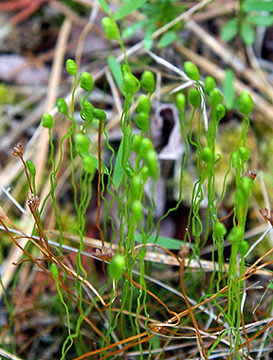Shinn's Road, Woodland Township, NJ
Phone: (609) 726-1191
www.state.nj.us/dep/parksandforests/parks/byrne.html
NJ Department of Environmental Protection
From the parking area at Michael Huber Prairie Warbler Preserve, turn Right on Sooy Place Road. After 3.5 miles, turn Left on Route 563. At the “T” intersection, turn Left onto Route 72 West. Take the first Right on an unmarked road, called “Buzzard Hill Road” on some maps. Proceed for 0.9 miles to the parking area at Pakim Pond on your Left. DIRECTIONS FROM NEAREST HIGHWAY: From the traffic circle at the intersection of Routes 70 and 72, known as ?Four Mile Circle?, continue East on Route 70 for 1.0 mile. Turn Right at the large brown sign for Brendan T. Byrne State Forest. Proceed 0.6 miles to the forest office which is on the Right. Proceed 2.0 miles on Shinn?s Road and bear Left on Coopers Road. Proceed 0.5 miles and the Pakim Pond parking area is on your Left. Map
 |
| Curly Grass Fern | Bill Geiger |
| |
| | Pakim Pond is a good starting point for study of the New Jersey Pine Barrens. Many typical species of both wildlife and plants can be seen here throughout the seasons. It is also a lovely spot with a covered pavilion for a picnic lunch.
On a warm, wet evening in late May or early June, night sounds abound. The parking lot will be closed, so park along a nearby sand road. Listen for Fowler’s toad, green frog, leopard frog, and carpenter frog – this last named for the thunka-thunka-thunk of its call, like the sound of a carpenter hammering. Distant calls might include the wonka-wonk call of the rare pine barrens treefrog, Whip-poor-wills or Barred Owl.
Feeding flocks of Tufted Titmouse, Carolina Chickadee, and Downy and Hairy Woodpecker will be moving through the trees.
Pine Warbler and Eastern Phoebe arrive in March. Leatherleaf, a low shrub of the wet woods, blooms in April, with small white bell-shaped flowers. Neotropical migrant birds arrive and settle in. Pine barren golden heather blooms along roadsides in May, with yellow flowers on a very low-growing shrub. Most amphibian species are breeding.
June and early July is the peak of spring wildflower season in the wetlands of the Pine Barrens. Blueberries ripen in late June and early July.
Autumn colors make wonderful reflections in the surface of the pond, and neotropical bird migration is underway. Cranberries are harvested commercially nearby, but a few “wild” berries can be found growing in many wet places. Winter resident birds like Dark-eyed Junco and White-throated Sparrow arrive. Goldenrods and asters bloom.
A more thorough study of this large area requires more time and is well work the effort. Try turning Left on the well-maintained, unpaved road just 0.6 miles past the Park office on Shinn’s Road. The 735-acre Cedar Swamp Natural Area begins 0.6 miles up the road. Stop, look and listen. Continue on this road for another 0.2 miles to a T-intersection. Turn Right and continue for about 1.5 miles to Pakim Pond, which will be on the Left immediately after returning to paved road. In June, along these roads, watch for the tall white flower spikes of Turkey beard, a Pine Barrens specialty plant.
Some interesting wildflowers can be seen along the path around the pond. Among them are several species of carnivorous plants, which “capture” insects to augment the limited supply of nutrients they receive from the sterile sands and peats of the pinelands. Pitcher plant, three species of sundews can be found. In the water are bladderworts, which have tiny ‘bladders’ on their underwater stems to trap small aquatic invertebrates. Look for their small, yellow, emergent flowers. Other plants include pipeworts, marsh Saint John’s-wort, Virginia meadow beauty, redroot, yellow-eyed grass, cranberry, several species of club mosses, and a variety of sedges and grasses.
|